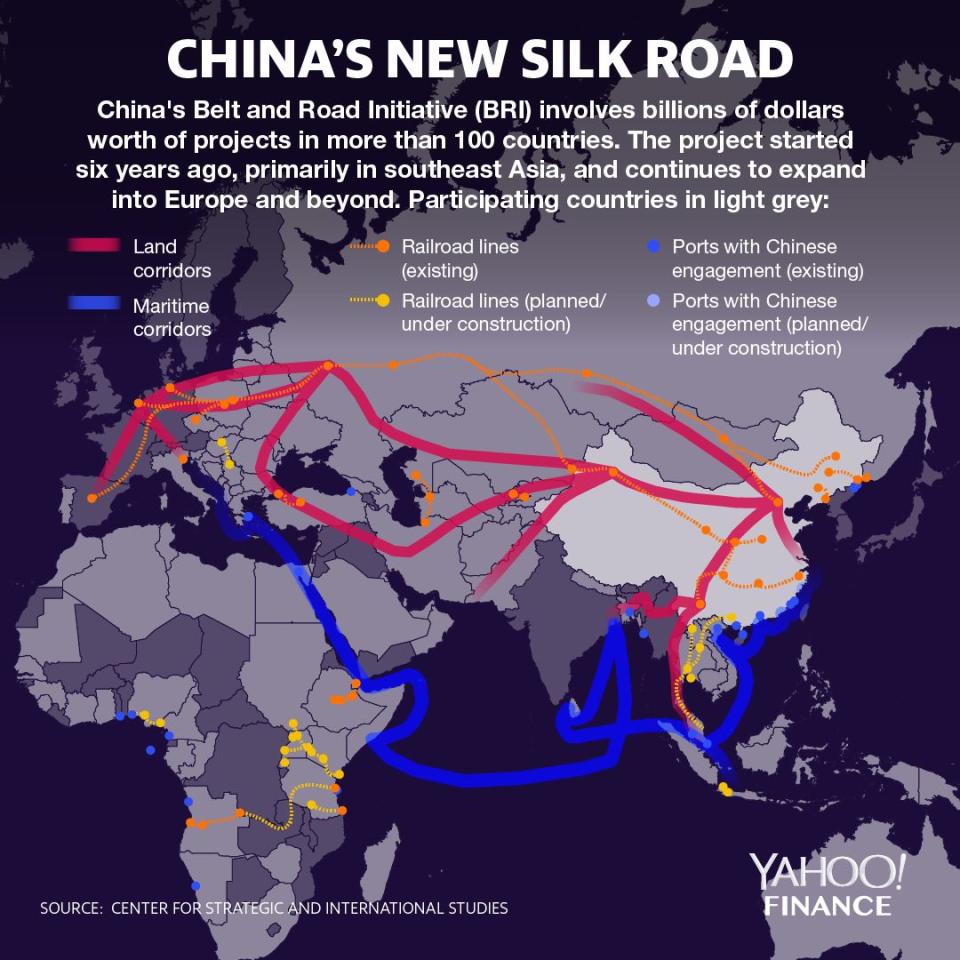Ex-WH economist: China’s New Silk Road is a 'threat to the existing system'
China’s new Silk Road represents a “threat to the existing system” and challenges America’s global financial leadership, according to a former White House economist.
The China’s desire to realign the global financial system to put the Chinese renminbi front and center an intended goal of its Belt and Road Initiative (BRI) or new Silk Road.
“From the U.S. perspective, obviously, we have been both providing the leadership in the global financial system, but we do derive benefits from it,” K.C. Fung, a former White House Council of Economic Advisers Senior International Economist under President George H.W. Bush and President Bill Clinton, told Yahoo Finance.
Since the U.S. dollar is the world's foremost currency, “we also use a system to sanction other economies,” Fung added, “by cutting them off from access to the global dollar liquidity, and so on.”
Fung, now a professor at the University of California Santa Cruz, said China wants to be “at least a co-equal in the next 30 years to the U.S.” Consequently, Beijing is pursuing various means to get its own system up and running — which is financial, technological, and other standards.

And from the U.S. perspective, that effort is “a threat to the existing system,” Fund said, adding that the existing world order that “we have maintained for several decades is challenged.”
‘Historic golden opportunity’ for the Chinese currency
China’s big Belt and Road Initiative (BRI) — which began in 2013 and hopes to bring Asia, Africa and Europe closer to China — has led to billions of dollars flowing out of China and into capital-hungry countries’ hands from Indonesia to Italy.
One part of the BRI is the Digital Silk Road, which develops communications networks across the developing world. According to D.C.-based consulting firm RWR Advisory Group, China has already spent $79 billion developing various projects from telecom infrastructure to facial recognition.
And investing in digital infrastructure could not just allow surveillance or an evolved form of neocolonialism, it could also serve Beijing’s desire to elevate Chinese renminbi (RMB) as a gold standard in finance.
“[The] Belt and Road Initiative is a great undertaking beneficial to all along the line,” Xinhua news, citing the executive director of China’s International Monetary Institute (IMI), reported in 2015 report. “It also offers a historic golden opportunity for RMB internationalization.”

And China’s official stance is that “financial integration is an important underpinning for implementing the Belt and Road Initiative,” according to a Silk Road Vision and Actions document from 2015. “We should deepen financial cooperation, and make more efforts in building a currency stability system, investment and financing system and credit information system in Asia.”
It also hopes to “support the efforts of governments of the countries along the Belt and Road and their companies and financial institutions with good credit-rating to issue Renminbi bonds in China.”
But if China does manage to take over the global financial system — by internationalizing the Chinese RMB — the Digital Silk Road would help China “circumvent external surveillance” and create “both an alternative and parallel to the U.S.-centered SWIFT system,” according to researchers at the UK-based Institute of Development Studies.
In such a scenario, countries affected by U.S. sanctions could potentially bypass those limitations and turn to the Chinese instead to retain their lifeline to the global financial system.

‘No evidence to panic’
Another expert said that there is no reason to be imminently worried about the U.S. dollar being dislodged by the renminbi as the global reserve currency.
“They’re a long, long way away from that,” Duff & Phelps Chief Strategist and former U.S. Treasury official Chris Campbell told Yahoo Finance. “The Chinese have a very long view... on economic strategies but I did not see any evidence of that while I was at the Treasury.”
Campbell emphasized that he saw “no evidence to panic [over] the degradation of the U.S. dollar as the common currency. The RMB is far from being in a place where it can displace the USD.”
China is “playing a very long game on this, there’s no question,” added Campbell, who served as the former assistant secretary of the U.S. Treasury for financial institutions. “But the reality is, the one thing that is frustrating them with the Trump administration, compared to previous administrations, is that... the strategy of talking a lot and just not doing a lot of action... is just not working with this President.”
Aarthi is a reporter for Yahoo Finance. Follow her on Twitter @aarthiswami.
Read more:
EU on the New Silk Road: China is both a 'partner' and a 'systemic rival'
The new Silk Road is China's 'second pillar of legitimacy' — and Europe is starting to buy in
Read the latest financial and business news from Yahoo Finance
Follow Yahoo Finance on Twitter, Facebook, Instagram, Flipboard, SmartNews, LinkedIn, YouTube, and reddit.
